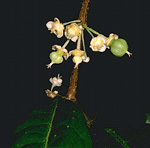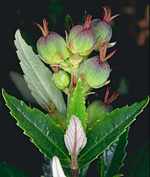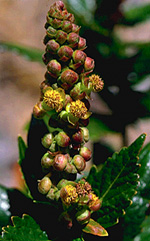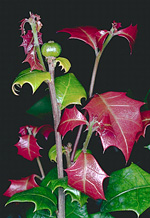 |
This is a very large and diverse, cosmopolitan family, relatively easily recognised but difficult to characterise. In Australia, members for the family are found in all regions except the high alps, but are most diverse in the eastern and north-eastern tropical rain forests. Relatively few penetrate the arid lands or into temperate regions. Interestingly, for such a large family, very few are weeds - only a few species of Euphorbia and one of Ricinus are naturalised weeds in Australia.
Characteristic features of the family Euphorbiaceae in Australia include: - trees or shrubs (less often herbs) with alternate (rarely opposite or vestigial or absent) simple (rarely palmatifid) leaves, often with small glands at the junstion of the blade and petiole, often with milky sap.
- flowers usually small (showy in many Ricinocarpos), unisexual, with one or two perianth whorls, sometimes (Euphorbia) entirely lacking a perianth but with several flowers aggregated into a 'false flower' surrounded by perianth-like glands
- ovary superior, usually 3-celled, often with branched or feathery styles
- fruit a capsule, a fleshy drupe or rarely a berry
Description
Evergreen or semi-deciduous trees or shrubs, rarely woody or herbaceous vines climbing by twining stems, or annual, biennial or perennial terrestrial herbs. Perennating by taproots or crowns. Leaves present or rarely ±absent. Stem internodes terete, oval or slightly flattened, strongly flattened or distinctly angular. Internal secretions not obvious or of milky sap (latex), or rarely of resin. Plants glabrous or with simple or stellate, non-glandular, unicellular or uniseriate hairs, or glandular hairs present as granular papillae, stinging hairs absent or rarely present, peltate scales rarely present. Leaves well developed, or much reduced (ie. to scales, etc.), or entirely absent, alternate and spiral or distichous, rarely opposite, cauline if herbs, petiolate, subsessile or sessile, or rarely peltate; pulvinae absent or rarely present. Stipules distinct and free from the petiole, or rarely interpetiolar, scale-like or membranous, or lacerate, or fimbriate, persistent or falling off early; stipellae rarely present. Lamina simple, or rarely ternately compound, symmetric or conspicuously asymmetric; lamina/leaflets filiform, acicular, subulate, linear, lanceolate, ovate, elliptic, oblanceolate, obovate, oblong, spathulate or orbicular, or rarely palmatifid or palmatisect; base cuneate, attenuate, rounded, cordate or oblique; margins entire, crenate or serrate, ±flat, revolute, recurved, involute or incurved; one-veined, or the venation pinnate, or rarely palmate, with the midrib conspicuous or inconspicuous, and the tertiary venation reticulate or not; surfaces punctate or not punctate; herbaceous, leathery, membranous or papery; distinctive odour absent or foetid. Male and female flowers occurring on the same plant or on separate plants. Inflorescences terminal, axillary or intercalary, consisting of cyathia, capitula or glomerules, spikes, racemes, corymbs, umbels or solitary flowers. Bracts and bracteoles present, herbaceous. Pollination by insects or wind. Flowers odourless or fragrant, sessile or stalked. Floral disc present or absent; nectaries absent or present on the disc. Perianth of 2 dissimilar whorls, or of 1 whorl only, or all whorls ±similar, or vestigial, or absent, with 0–6 (–10) segments. Calyx regular; segments free or fused, with (0–) 3–6 (–10) sepals or lobes, imbricate, valvate or open in bud; calyx cup-shaped, bell-shaped, urn-shaped, funnel-shaped or rarely tubular, herbaceous; margins entire, lobed or lacerate. Corolla regular, rarely irregular; segments free, with 0 or 4–5 (–6) petals, alternating with the sepals or calyx lobes, imbricate in bud, white, cream, pink or green, without contrasting markings, membranous; claws absent; lobes ±entire. Fertile stamens (1–) 3 (–numerous), opposite to or not clearly correlated with the sepals or calyx lobes, free of the corolla, free of the ovary and style, distinct from each other, fused by their filaments into an open or closed tube or fused by their anthers, all ±equal. Staminodes absent. Staminal filaments present or absent. Anthers dorsifixed, basifixed or apicifixed, not versatile, opening outwards, sideways or inwards by longitudinal slits, rarely by terminal pores or transverse slits, 2- (or 4-) celled; appendages absent or apical. Ovary superior and sessile or stalked. Carpels (2–) 3 (–4), fused; ovary with (1–) 3 (–25) locules. Style terminal, single and unbranched, or branched above or from the base and the stigma clavate, peltate, capitate or truncate. Ovules 1–2 per locule, stalked or sessile; placentation apical or axile. Fruit a dry, dehiscent septicidal or loculicidal capsule sometimes with explosive dehiscence, or a fleshy, indehiscent drupe; the perianth on the maturing fruit deciduous. Disseminule micro-surface ±smooth, echinate, alveolate, tuberculate, muricate, colliculate, papillate, reticulate, sulcate, rugose or verrucose, cream, orange, red, magenta, purple, violet, blue, green, brown or black, glossy or dull. Seeds 1–12 or more per fruit. Aril present or absent. Cotyledons 2. Embryo straight or curved.
(Note: this description has been generated from the coded data compiled for the key. Any errors in the key data will be reflected in the descriptions.)
A treatment of the family Euphorbiaceae has not yet been published in the Flora of Australia. It will appear in Volume 23.
Australian genera of Euphorbiaceae (as recognised for the Flora of Australia)
† = some species native, others introduced
* = all species introduced
Acalypha
Actephila
Adriana
Alchornea
Aleurites
Amperea
Andrachne
Antidesma
Austrobuxus
Baloghia
Bertya
Beyeria
Bischofia
Breynia
Bridelia
Calycopeplus
Chamaesyce
Choriceras
*Chrozophora
Claoxylon
Cleidion
Cleistanthus
Codiaeum
Coelobogyne
Croton
Dimorphocalyx
Dissiliaria
Drypetes
Endospermum
*Eremocarpus
†Euphorbia
Excoecaria
Fluggea
Fontainea
Glochidion
Homalanthus
Hylandia
Jatropha
Leptopus
Macaranga
Mallotus
*Manihot
Margaritaria
*Mercurialis
Micrantheum
*Micrococca
Monotaxis
Neoroepera
Omalanthus
Omphalea
Oreoporanthera
Petalostigma
Phyllanthus
Pimelodendron
Poranthera
Pseudanthus
Ricinocarpos
*Ricinus
Rockinghamia
Sapium
Sauropus
Sebastiania
Securinega
Stachystemon
Suregada
Tragia
Trigonostemon
*Vernicia
Whyanbeelia

|
  |

Actephila lindleyi (flowers)
Photo: M.Fagg © M.Fagg

Adriana klotzschii (female flowers)
Photo: M.Fagg © ANBG

Adriana klotzschii (male flowers)
Photo: D.Jones © D.Jones

Alchornea ilicifolia (fruiting plant)
Photo: M.Fagg © ANBG

|
 |
|